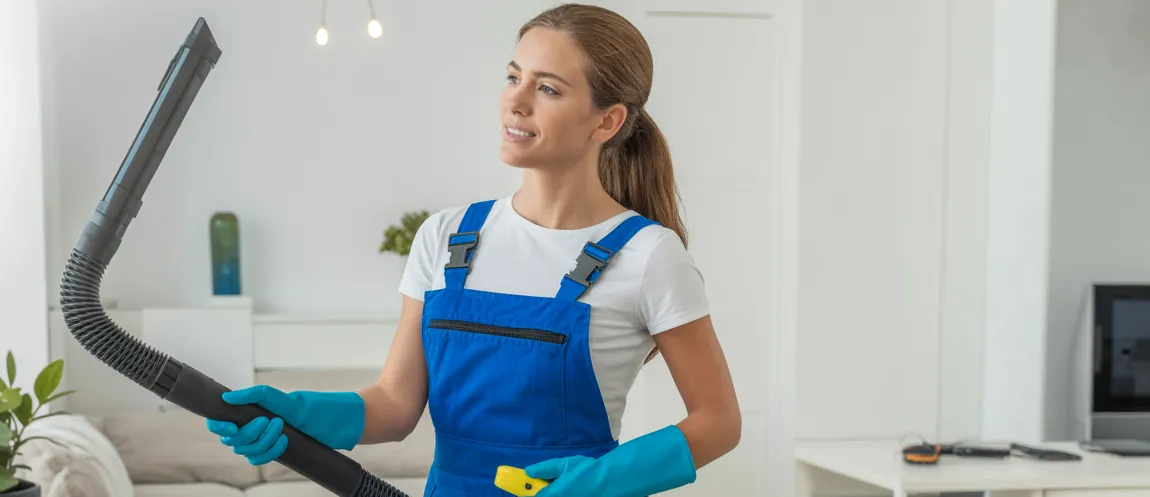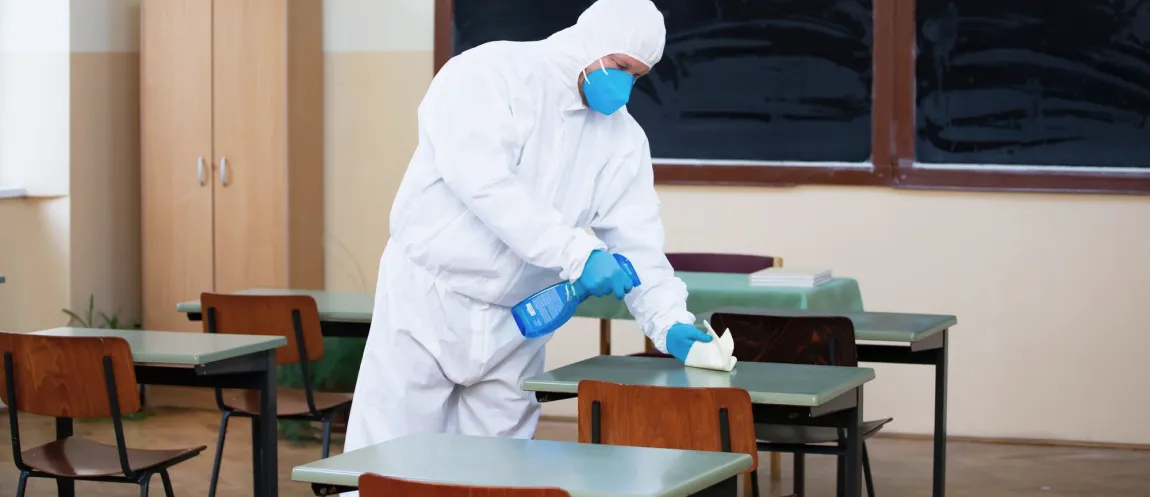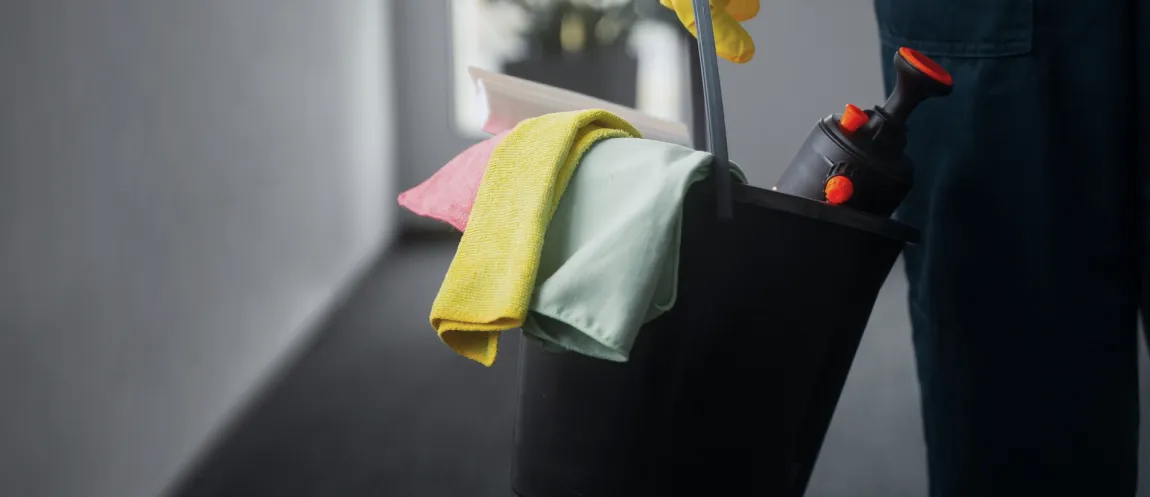People dealing with allergies should include housework in their allergy management plans. After all, cleaning can reduce the allergens in your home, easing your allergy symptoms. But be cautious, as some cleaning products can cause allergy-like symptoms for certain individuals.
The best way to avoid such irritations from products is to have someone in your house who doesn’t have allergies or a professional cleaning service provider handle the cleaning. Even the act of cleaning, like sweeping, can trigger allergic reactions because it stirs up dust and other allergens.
However, if you have allergies and need to do the cleaning yourself, using products less likely to trigger allergy symptoms can be helpful.
How Often Should You Clean Your House If You Have Allergies?
Allergy sufferers understand the frustration of dealing with allergies, especially when triggered in the comfort of their homes. Therefore, it’s valuable to familiarize yourself with the cleaning routines that professional service providers in the USA recommend for people like you.
Unlike those fortunate individuals who’ve never checked the pollen forecast, if you have allergies, staying on top of your cleaning routine ensures that your home doesn’t become an allergy trigger zone. Also, a consistent cleaning schedule is key. Distribute your cleaning tasks throughout the week so that you only need to perform a small amount of maintenance each day.
While regular cleaning is the most effective way to keep allergy symptoms in check, it can also exacerbate them if not carried out correctly. Besides, be mindful of your cleaning methods and implement them consistently to achieve the best results in allergy-proofing your home.
It’s worth noting that for people with allergies, ‘regular’ cleaning goes beyond quick dusting and vacuuming. Additional tasks like washing bedding, curtains, and upholstery, wiping down surfaces, and using a HEPA filter are unavoidable measures in reducing allergens effectively. Once in a while, you can get professionals in NYC to deep clean your house.
Book our expert cleaning services today for a spotless, allergy-proof space!
Service Areas:
NYC: dllcleaningservices.com/new-york-city
Manhattan: dllcleaningservices.com/manhattan
Queens: dllcleaningservices.com/queens
Yonkers: dllcleaningservices.com/yonkers
Brooklyn: dllcleaningservices.com/brooklyn
What Are The Symptoms Of Dust Mite Allergy?
Dust mite allergy occurs when you have an allergic reaction to tiny bugs that often inhabit household dust. The symptoms are similar to hay fever, like sneezing and a runny nose. Moreover, many people with dust mite allergy encounter asthma symptoms, such as wheezing and breathing difficulties.
These mites, close relatives of ticks and spiders, are too tiny to be seen without a microscope. They feed on skin cells shed by people and thrive in warm, humid environments. Most homes provide them with an ideal setting in items like bedding, upholstered furniture, and carpeting.
Symptoms
● Sneezing
● Runny nose
● Itchy, red, or watery eyes
● Nasal congestion
● Itchy nose, roof of the mouth, or throat
● Postnasal drip
● Cough
● Facial pressure and pain
● Swollen, blue-colored skin under the eyes
● In a child, frequent upward nose rubbing
If dust mite allergy leads to asthma, you may also experience:
● Difficulty breathing
● Chest tightness or pain
● Audible whistling or wheezing when exhaling
● Trouble sleeping due to shortness of breath, coughing, or wheezing
● Coughing or wheezing episodes worsened by respiratory viruses like colds or the flu.
15 Best House Cleaning Tips for People with Allergies
1. Put On a Mask
This may seem basic, but a top cleaning tip for allergy-friendly folks is to wear a mask.
● Pick a mask that covers both your mouth and nose for added protection.
● If you tend to get skin irritations, wearing gloves is also smart.
Dust stirred up during your thorough cleaning can linger in the air. So after you’re done, keep the mask on for a few hours or, if possible, step outside to let things settle.
2. Use Damp Microfiber Cloths Instead Of Dusters
If you want to get rid of dust, go for a microfiber cloth, whether you have allergies or not. They don’t just shuffle dust around like regular cotton cloths; they actually draw it in. Yes, especially when they’re a bit damp!
Besides, for hard or wooden floors, simplify things by using a microfiber mop.
3. Get An Air Purifier
Opening doors and windows might not be the best solution during the summer when pollen and other airborne irritants are abundant. Investing in an air purifier can significantly improve your indoor air quality. Besides handling chemicals, air purifiers also get rid of odors, so you won’t need synthetic air fresheners – those are a no-go for allergy sufferers due to the harmful toxins they contain.
For optimal results, pick a model with a HEPA filtration system and remember to change the filters regularly.
4. Add a Couple of Houseplants
Moreover, some scientists have also suggested that selecting the right houseplants can positively impact the air you breathe. Purifying options include snake plants, aloe vera, and dracaena. Peace lilies and spider plants are also effective at naturally preventing mold. Besides, just make sure to occasionally wipe down their leaves with a damp cloth to prevent dust buildup.
5. Use a Vacuum Instead of Sweeping
When you sweep, you basically move the dirt and dust around from one place to another. It’s a lot like dusting with a dry cloth, which causes those particles to float up into the air. That’s why it’s smarter to go with a vacuum cleaner that comes with (again) a High-Efficiency Particulate Air (HEPA) filter. This way, the vacuum cleaner not only picks up the dirt but also keeps it locked in instead of releasing it back into the air.
Further, the cleaning companies in the USA take good care of this practice. You can always reach out to them.
6. Start at the Top When Cleaning
The age-old advice of beginning your cleaning from the highest point makes sense. When you clean higher spots like the tops of cupboards or curtain rods, the dust falls down and lands on surfaces below. To save yourself from cleaning the same areas twice, start by cleaning the upper parts of your home and work your way down until you reach the floor.
7. Maintain a Clean Kitchen to Prevent Fumes and Pests
● Decrease moisture by daily cleaning with vinegar and water solution. Also, make sure to dry areas around the counter, sink, and under the drying rack.
● Keep your kitchen dishcloths clean and dry as well.
● Moreover, keep the lids of your garbage bins closed and regularly empty them.
This routine will discourage pests like cockroaches and rodents from visiting your home. Be sure to clean your bin regularly, too!
8. Keep Things Dust-Free by Storing Them
To avoid dust buildup, put things like games, toys, jewelry, and arts and crafts items in clear plastic containers with lids or in closed cupboards. Certainly, it will simplify your house cleaning routine.
9. Frequently Clean Fabrics
Upholstered sofas can collect a lot of dirt, bacteria, and allergens. A simple way to tackle this is by using a washable couch cover that you clean weekly. Also, make sure to wash your curtains, sheets, and stuffed animals regularly. Besides, let them completely dry before putting them away.
If you can, opt for blinds or shades instead of curtains, as they gather less dust.
10. Steam Clean Your Carpets and Guard Your Mattress
Shield your mattress and pillows with anti-allergen protectors. If you have allergies, avoiding carpets in your home or bedroom is best. However, if you have carpets, steam clean them to eliminate dust mites.
11. Declutter Your Home
Our homes tend to be filled with lots of unnecessary and unused stuff. Additionally, these cluttered items take up valuable space and gather dust.
● To address this, declutter your home every 3-6 months.
● Sell, donate, or give away items you no longer use or need.
● Consider hiring a professional spring cleaning service once a year to keep things in check.
12. Prevent Bathroom Mold
● Routinely clean your tiles by spraying distilled white vinegar on the walls and letting them air-dry.
● After a shower, use a microfiber cloth or squeegee to wipe the tiles dry.
● Also, always clean your shower curtain and let it dry completely to stop mold and mildew from forming.
● To ventilate and dry your bathroom, use an exhaust fan and/or open the door and windows.
● If you spot any bathroom leaks, get them fixed without delay.
13. Tidy Up Outside Entryways
Maintaining the walkway to your house, your patio, and the space near your front door in good order doesn’t just make things look nice. It also reduces the amount of dust, dirt, and pollen that gets brought into your home.
14. Take Off Your Shoes before Coming Inside
The soles of your shoes can carry all sorts of unpleasant stuff like dust, bird droppings, dog waste, and leaves. It is time to take off your shoes either at the doorstep or in the mudroom before you step inside your home and ask your guests to do the same.
15. Avoid Carpet Shampooing
Steering clear of carpet shampooing and strong-smelling cleaners can help prevent your allergies from worsening.
Do you have a carpet section with mold or mildew? Clean the back of it with a mixture of one part hydrogen peroxide and five parts water. Now, lift up that part of the carpet and dry the treated area with a fan.
Takeaway
Allergies can ruin your coziest days, especially when you let the very reason for them inhabit your house. Yet, companies like DLL Cleaning Services are taking care of this for people throughout the USA. So, you can just sit back and let us help you.




